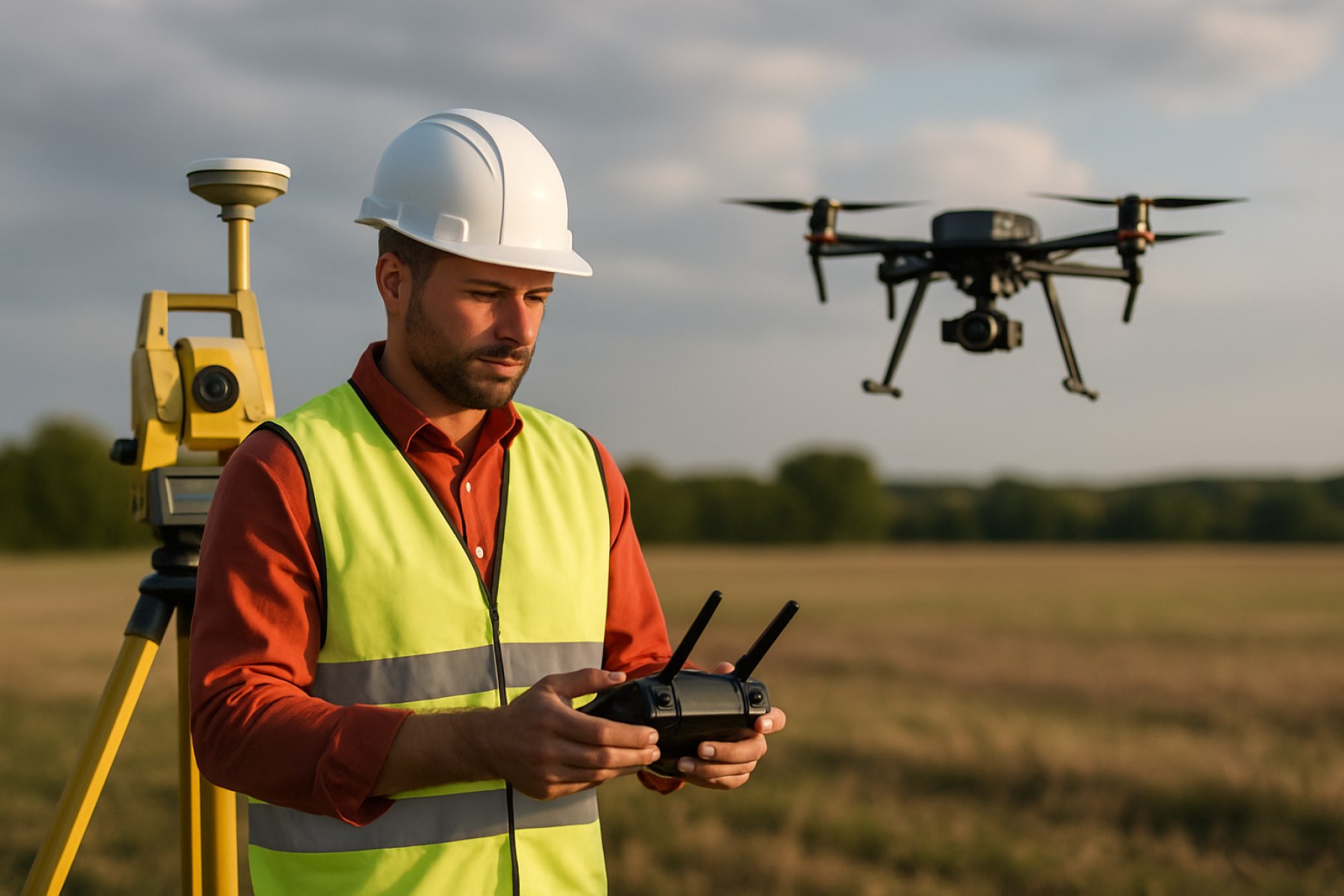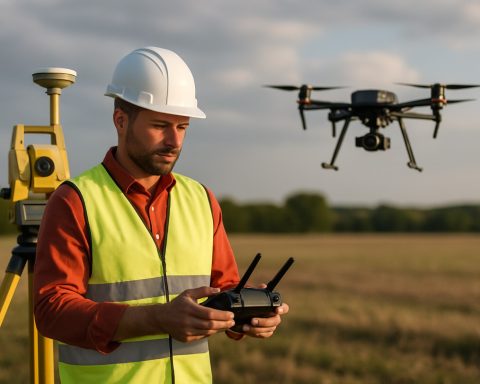Geodetic Drone Surveying Systems in 2025: Transforming Precision Mapping and Land Measurement. Explore the Technologies, Market Dynamics, and Future Outlook Shaping the Next Era of Geospatial Intelligence.
- Executive Summary: Key Trends and Market Drivers in 2025
- Market Size and Forecast (2025–2030): Growth Projections and CAGR Analysis
- Technological Innovations: Sensors, GNSS, and AI Integration
- Competitive Landscape: Leading Manufacturers and Strategic Partnerships
- Regulatory Environment and Industry Standards (e.g., FIG, ICAO)
- Applications: Infrastructure, Construction, Agriculture, and Environmental Monitoring
- Regional Analysis: North America, Europe, Asia-Pacific, and Emerging Markets
- Challenges: Data Security, Airspace Management, and Operational Limitations
- Case Studies: Real-World Deployments and Measured Impact
- Future Outlook: Autonomous Systems, Market Expansion, and Next-Gen Capabilities
- Sources & References
Executive Summary: Key Trends and Market Drivers in 2025
Geodetic drone surveying systems are poised for significant growth and transformation in 2025, driven by rapid advancements in sensor technology, automation, and integration with geospatial data platforms. The adoption of drones equipped with high-precision GNSS (Global Navigation Satellite System) receivers, LiDAR, and photogrammetric cameras is accelerating, enabling surveyors to achieve centimeter-level accuracy over large and complex terrains. This technological leap is being propelled by leading manufacturers such as DJI, Leica Geosystems, and Trimble, all of whom have expanded their portfolios to include turnkey geodetic UAV solutions tailored for land surveying, construction, mining, and infrastructure monitoring.
A key trend in 2025 is the integration of real-time kinematic (RTK) and post-processed kinematic (PPK) positioning systems directly into drone platforms. This allows for immediate georeferencing of survey data, reducing the need for ground control points and expediting project timelines. Companies like senseFly (a Parrot company) and Topcon Positioning Systems are at the forefront, offering drones and payloads that seamlessly interface with existing geodetic workflows and GIS software.
Regulatory developments are also shaping the market landscape. In 2025, more countries are streamlining drone flight permissions for professional surveying, particularly for beyond visual line of sight (BVLOS) operations. This regulatory easing is expected to unlock new applications in corridor mapping, large-scale cadastral surveys, and disaster response. Industry bodies such as the Unmanned Aerial Vehicle Systems Association are actively collaborating with civil aviation authorities to establish standards for data quality, safety, and interoperability.
Data fusion and cloud-based processing are emerging as critical drivers. Surveying firms increasingly rely on platforms that combine drone-captured imagery with satellite, terrestrial, and IoT data for richer geospatial insights. Companies like Hexagon and Autodesk are investing in cloud ecosystems that support automated data upload, processing, and analytics, reducing turnaround times and enabling real-time decision-making.
Looking ahead, the geodetic drone surveying sector is expected to see continued investment in AI-powered feature extraction, autonomous flight planning, and multi-sensor payloads. As hardware costs decline and regulatory frameworks mature, the accessibility and utility of drone-based geodetic surveys will expand, supporting smarter infrastructure, environmental monitoring, and digital twin initiatives worldwide.
Market Size and Forecast (2025–2030): Growth Projections and CAGR Analysis
The global market for geodetic drone surveying systems is poised for robust growth between 2025 and 2030, driven by accelerating adoption across construction, mining, agriculture, and infrastructure development. The integration of high-precision GNSS, LiDAR, and photogrammetry sensors into unmanned aerial vehicles (UAVs) has significantly enhanced the accuracy and efficiency of geospatial data collection, fueling demand for advanced surveying solutions.
Industry leaders such as DJI, Leica Geosystems, Trimble, and senseFly (a Parrot company) are at the forefront, offering integrated drone platforms tailored for geodetic applications. These companies have reported increased investments in R&D and strategic partnerships to expand their product portfolios and address evolving customer requirements. For instance, Trimble continues to enhance its UAV solutions with advanced GNSS and real-time kinematic (RTK) capabilities, while Leica Geosystems focuses on seamless integration with its established geospatial software ecosystem.
The market size for geodetic drone surveying systems is expected to surpass USD 2.5 billion by 2025, with a projected compound annual growth rate (CAGR) ranging from 15% to 18% through 2030. This growth is underpinned by increasing regulatory acceptance of UAV operations for commercial surveying, particularly in North America, Europe, and parts of Asia-Pacific. The United States Federal Aviation Administration (FAA) and the European Union Aviation Safety Agency (EASA) have both streamlined drone regulations, enabling broader deployment of UAVs for professional geodetic tasks.
Key growth drivers include the rising need for rapid, cost-effective, and high-accuracy mapping in large-scale infrastructure projects, urban planning, and environmental monitoring. The mining sector, for example, is leveraging drone-based geodetic surveys for volumetric analysis and site planning, while the construction industry benefits from real-time progress tracking and as-built documentation. Additionally, the integration of artificial intelligence and cloud-based data processing is expected to further accelerate market expansion by simplifying workflows and reducing turnaround times.
Looking ahead, the geodetic drone surveying systems market is anticipated to witness continued innovation, with major players such as DJI and senseFly investing in autonomous flight technologies and enhanced sensor payloads. As end-users increasingly demand higher accuracy and operational efficiency, the sector is set to maintain double-digit growth, solidifying UAVs as a cornerstone of modern geospatial surveying.
Technological Innovations: Sensors, GNSS, and AI Integration
Geodetic drone surveying systems are undergoing rapid technological transformation in 2025, driven by advances in sensor miniaturization, high-precision GNSS (Global Navigation Satellite System) integration, and the adoption of artificial intelligence (AI) for data processing and automation. These innovations are enabling survey-grade accuracy, faster data acquisition, and more efficient workflows across construction, mining, infrastructure, and environmental monitoring sectors.
A key trend is the proliferation of high-resolution LiDAR and photogrammetric sensors tailored for UAV platforms. Companies such as Leica Geosystems and RIEGL are at the forefront, offering lightweight airborne LiDAR scanners capable of capturing dense point clouds with centimeter-level accuracy. These sensors are increasingly paired with multispectral and hyperspectral cameras, expanding the analytical capabilities of geodetic drones for applications like vegetation analysis and material classification.
GNSS technology is also seeing significant improvements. The integration of multi-frequency, multi-constellation GNSS receivers—supporting GPS, GLONASS, Galileo, and BeiDou—has become standard in professional drone surveying systems. Topcon Positioning Systems and Trimble are notable for their robust GNSS modules, which, when combined with real-time kinematic (RTK) and post-processed kinematic (PPK) correction services, deliver georeferencing accuracy down to the centimeter or even sub-centimeter level. This is critical for cadastral mapping, infrastructure monitoring, and precision agriculture.
AI integration is reshaping the data processing landscape. Modern geodetic drone systems leverage onboard and cloud-based AI algorithms for real-time object detection, automated feature extraction, and anomaly identification. DJI, a global leader in commercial drones, has incorporated AI-driven flight planning and obstacle avoidance, while also enabling third-party software integration for advanced geospatial analytics. Meanwhile, senseFly (a Parrot company) and Delair are focusing on end-to-end solutions that automate photogrammetric processing, 3D modeling, and change detection, reducing manual intervention and turnaround times.
Looking ahead, the next few years are expected to bring further convergence of these technologies. The adoption of edge computing will allow more sophisticated AI models to run directly on drones, enabling in-flight data validation and adaptive mission planning. Enhanced interoperability between sensors, GNSS modules, and AI platforms will drive the development of fully autonomous geodetic surveying workflows, setting new standards for accuracy, efficiency, and scalability in the geospatial industry.
Competitive Landscape: Leading Manufacturers and Strategic Partnerships
The competitive landscape for geodetic drone surveying systems in 2025 is characterized by rapid technological innovation, strategic partnerships, and a clear focus on integrating advanced geospatial capabilities. The market is led by a handful of established drone manufacturers, specialized sensor providers, and geospatial technology firms, each vying to deliver higher accuracy, efficiency, and automation for surveying professionals.
Among the most prominent players, DJI continues to dominate the global commercial drone market, including geodetic applications, with its Matrice series and the integration of high-precision RTK/PPK modules. DJI’s collaborations with software providers and sensor manufacturers have enabled end-to-end solutions for topographic mapping, construction, and infrastructure monitoring. Another key player, senseFly (a Parrot company), is recognized for its fixed-wing eBee drones, which are widely used in large-scale geodetic and cadastral surveys due to their endurance and compatibility with photogrammetric and LiDAR payloads.
In the sensor domain, Leica Geosystems (part of Hexagon AB) and RIEGL are at the forefront, offering high-precision GNSS receivers and airborne LiDAR scanners tailored for UAV integration. Leica’s partnerships with drone manufacturers have resulted in seamless workflows from data capture to processing, while RIEGL’s miniaturized LiDAR sensors are increasingly adopted for corridor mapping and forestry applications.
Strategic alliances are shaping the sector’s evolution. For example, Trimble has expanded its geospatial ecosystem through collaborations with both drone hardware and software companies, enabling direct integration of its GNSS and data management platforms. Similarly, Topcon Positioning Systems is leveraging partnerships to offer complete UAV-based surveying solutions, combining its GNSS expertise with third-party UAVs and cloud-based processing.
Emerging players such as Delair and Quantum Systems are gaining traction in Europe and beyond, focusing on hybrid VTOL (vertical takeoff and landing) drones and AI-driven data analytics for geodetic applications. These companies are increasingly forming partnerships with national mapping agencies and large engineering firms to address complex surveying needs.
Looking ahead, the competitive landscape is expected to intensify as manufacturers invest in AI-powered automation, multi-sensor payloads, and cloud-based geospatial platforms. Strategic partnerships—especially those bridging hardware, software, and data services—will be crucial for delivering integrated, scalable solutions to meet the growing demand for high-precision geodetic drone surveying worldwide.
Regulatory Environment and Industry Standards (e.g., FIG, ICAO)
The regulatory environment for geodetic drone surveying systems is rapidly evolving as the technology matures and its adoption accelerates across sectors such as construction, mining, and infrastructure monitoring. In 2025, regulatory bodies and industry standards organizations are focusing on harmonizing operational guidelines, safety protocols, and data quality requirements to ensure the reliability and legal acceptance of drone-derived geospatial data.
At the international level, the International Civil Aviation Organization (ICAO) continues to play a pivotal role in shaping the global framework for unmanned aircraft systems (UAS) operations. ICAO’s guidance, particularly through its UAS Advisory Group, is influencing national aviation authorities to develop risk-based, performance-oriented regulations for beyond visual line of sight (BVLOS) operations, which are critical for large-scale geodetic surveys. In 2025, ICAO is expected to further refine its Model UAS Regulations, with a focus on integrating UAS into controlled airspace and standardizing remote identification requirements.
On the geospatial data side, the International Federation of Surveyors (FIG) is actively updating its standards and best practices for drone-based geodetic surveying. FIG’s Commission 5 (Positioning and Measurement) is collaborating with national mapping agencies and industry stakeholders to address issues such as absolute accuracy, metadata standards, and the traceability of drone-derived coordinates to global reference frames. These efforts are aimed at ensuring that drone surveys meet the rigorous requirements of cadastral, engineering, and scientific applications.
National authorities are also tightening their frameworks. For example, the Federal Aviation Administration (FAA) in the United States and the European Union Aviation Safety Agency (EASA) are both expanding their regulatory regimes for commercial drone operations. In 2025, both agencies are expected to implement stricter requirements for operator certification, airspace integration, and data security, particularly for drones used in critical infrastructure and public sector projects.
Industry standards are being shaped by both regulatory mandates and technological advances. Leading drone manufacturers such as DJI and senseFly (a Parrot company) are working closely with standards bodies to ensure their geodetic drone systems comply with evolving requirements for GNSS accuracy, flight safety, and data interoperability. These collaborations are expected to result in new technical standards for payload calibration, real-time kinematic (RTK) positioning, and secure data transmission by 2026.
Looking ahead, the regulatory landscape for geodetic drone surveying will likely become more unified, with increased cross-border recognition of certifications and data standards. This will facilitate broader adoption of drone-based geodetic methods, while ensuring that safety, privacy, and data integrity remain at the forefront of industry practice.
Applications: Infrastructure, Construction, Agriculture, and Environmental Monitoring
Geodetic drone surveying systems are rapidly transforming key sectors such as infrastructure, construction, agriculture, and environmental monitoring, with 2025 marking a period of accelerated adoption and technological refinement. These systems, equipped with high-precision GNSS receivers, LiDAR, and photogrammetric sensors, are enabling centimeter-level accuracy in mapping and data collection, which is critical for modern project demands.
In infrastructure and construction, geodetic drones are now integral to site planning, progress monitoring, and quality assurance. Major construction firms and public agencies are leveraging drones to conduct topographic surveys, volumetric calculations, and as-built documentation, reducing survey times from weeks to days. Companies like Leica Geosystems and Trimble have introduced drone platforms and software ecosystems that integrate seamlessly with existing geospatial workflows, supporting BIM (Building Information Modeling) and digital twin initiatives. The ability to rapidly generate accurate 3D models is streamlining decision-making and minimizing costly rework.
In agriculture, geodetic drone systems are being deployed for precision farming applications, including field mapping, crop health assessment, and yield prediction. Drones equipped with multispectral and hyperspectral sensors provide actionable insights at the plant level, enabling variable rate application of inputs and optimizing resource use. DJI, a leading drone manufacturer, has expanded its agricultural drone offerings with RTK-enabled models, allowing farmers to conduct high-accuracy surveys for drainage planning, soil analysis, and land leveling. These advancements are contributing to increased productivity and sustainability in the sector.
Environmental monitoring is another area experiencing significant benefits from geodetic drone surveying. Drones are being used to monitor coastal erosion, forest health, and habitat changes with unprecedented spatial and temporal resolution. Organizations such as senseFly (a Parrot company) and Topcon Positioning Systems are providing solutions tailored for environmental professionals, including fixed-wing drones for large-area surveys and cloud-based data processing platforms. These tools are supporting climate adaptation strategies and regulatory compliance by delivering timely, accurate geospatial data.
Looking ahead, the next few years will see further integration of AI-driven analytics, real-time data transmission, and enhanced autonomy in geodetic drone systems. Regulatory frameworks are evolving to support beyond visual line of sight (BVLOS) operations, which will expand the scope and efficiency of drone-based surveying. As hardware costs continue to decrease and software capabilities advance, geodetic drone surveying is poised to become a standard tool across infrastructure, construction, agriculture, and environmental monitoring worldwide.
Regional Analysis: North America, Europe, Asia-Pacific, and Emerging Markets
The geodetic drone surveying systems market is experiencing dynamic growth and technological advancement across North America, Europe, Asia-Pacific, and emerging markets, with each region exhibiting distinct drivers and adoption patterns as of 2025 and looking ahead.
North America remains a global leader in geodetic drone surveying, propelled by robust infrastructure investment, regulatory clarity, and a mature ecosystem of drone manufacturers and service providers. The United States, in particular, benefits from the Federal Aviation Administration’s (FAA) progressive integration of drones into the National Airspace System, enabling expanded commercial applications. Major players such as Trimble and DJI (with significant US operations) continue to innovate in high-precision GNSS-enabled drones and integrated software platforms. The Canadian market is also notable, with companies like Microdrones supporting resource mapping and infrastructure monitoring in remote regions.
Europe is characterized by strong regulatory harmonization under the European Union Aviation Safety Agency (EASA), fostering cross-border drone operations and standardization. Countries such as Germany, France, and the UK are at the forefront, leveraging geodetic drone systems for large-scale infrastructure, environmental monitoring, and smart city projects. European manufacturers, including senseFly (a Parrot company) and Leica Geosystems, are recognized for their advanced fixed-wing and rotary UAVs equipped with RTK/PPK GNSS and LiDAR payloads. The region is also seeing increased public-private partnerships to digitize land administration and accelerate climate resilience initiatives.
Asia-Pacific is witnessing rapid adoption, driven by large-scale infrastructure development, urbanization, and government-backed digital mapping programs. China is a dominant force, with DJI holding a significant share of the global and regional market, offering a wide range of geodetic-capable drones. Japan and South Korea are investing in precision agriculture and disaster management, utilizing drones for high-resolution terrain modeling and post-disaster assessment. Australia’s mining and construction sectors are also major adopters, with local firms integrating drone data into geospatial information systems for operational efficiency.
Emerging markets in Latin America, Africa, and Southeast Asia are increasingly leveraging geodetic drone surveying to overcome traditional mapping challenges, such as inaccessible terrain and limited ground infrastructure. Adoption is supported by international development agencies and technology transfer from established manufacturers. Companies like Trimble and Leica Geosystems are expanding their presence through local partnerships and training programs, aiming to build capacity for land management, urban planning, and resource monitoring.
Looking forward, the outlook for geodetic drone surveying systems is robust across all regions, with continued advancements in sensor integration, real-time data processing, and regulatory frameworks expected to drive further adoption and innovation through the late 2020s.
Challenges: Data Security, Airspace Management, and Operational Limitations
Geodetic drone surveying systems are rapidly transforming the landscape of land measurement, construction, and infrastructure monitoring. However, as their adoption accelerates in 2025 and beyond, several critical challenges persist—particularly in the realms of data security, airspace management, and operational limitations.
Data Security: The proliferation of high-resolution geospatial data collected by drones raises significant concerns about data privacy and protection. Sensitive information, such as topographical maps of critical infrastructure or private properties, is increasingly stored and transmitted via cloud-based platforms. Leading manufacturers like DJI and senseFly have responded by implementing encrypted data links and secure data storage protocols. Nevertheless, the risk of cyberattacks and unauthorized data access remains a pressing issue, especially as regulatory frameworks struggle to keep pace with technological advancements. In 2025, industry bodies such as UAVSA are advocating for standardized cybersecurity guidelines tailored to drone operations, but widespread adoption and enforcement are still in development.
Airspace Management: The integration of drones into national airspace systems is a complex challenge, particularly as the number of commercial and industrial drone flights increases. In 2025, regulatory agencies and industry leaders are collaborating to develop Unmanned Aircraft System Traffic Management (UTM) solutions. Companies like Parrot and Trimble are actively participating in pilot programs and partnerships with aviation authorities to test real-time tracking, geofencing, and automated flight authorization systems. However, the lack of harmonized regulations across regions and the technical limitations of current UTM platforms—such as latency and scalability—continue to hinder seamless integration. The outlook for the next few years includes incremental improvements, with a focus on interoperability and cross-border coordination.
Operational Limitations: Despite advances in drone hardware and software, operational constraints persist. Battery life, payload capacity, and weather resistance are ongoing technical hurdles. For example, even advanced surveying drones from Leica Geosystems and Topcon Positioning Systems are typically limited to flight times under an hour, restricting coverage area per sortie. Additionally, regulatory restrictions—such as line-of-sight requirements and altitude limits—imposed by aviation authorities further constrain operational flexibility. In 2025, manufacturers are investing in hybrid power systems and AI-driven flight planning to extend range and autonomy, but widespread deployment of these innovations is expected to take several years.
In summary, while geodetic drone surveying systems are poised for continued growth, addressing data security, airspace management, and operational limitations will be crucial for unlocking their full potential in the coming years.
Case Studies: Real-World Deployments and Measured Impact
Geodetic drone surveying systems have rapidly transitioned from experimental technology to essential tools in geospatial data collection, infrastructure development, and environmental monitoring. In 2025, several high-profile deployments and case studies illustrate the measurable impact of these systems across diverse sectors.
One notable example is the use of geodetic drones in large-scale infrastructure projects. DJI, a global leader in drone manufacturing, has partnered with construction and engineering firms to deploy its Matrice series equipped with RTK (Real-Time Kinematic) modules. These drones have been used to survey highway expansions and bridge construction sites, delivering centimeter-level accuracy in topographic mapping. The integration of RTK and PPK (Post-Processed Kinematic) technologies has reduced field time by up to 60% compared to traditional ground-based surveying, while also minimizing safety risks for personnel.
In the energy sector, senseFly (a Parrot company) has documented the deployment of its eBee X fixed-wing drones for geodetic surveys of solar farm installations in Europe and North America. These projects required precise digital elevation models (DEMs) to optimize panel placement and drainage planning. The use of drone-based photogrammetry and GNSS correction enabled project teams to complete surveys in a fraction of the time, with accuracy validated against ground control points. According to senseFly, clients reported a 40% reduction in project lead times and significant cost savings on labor and equipment.
In environmental monitoring, Leica Geosystems has provided geodetic drone solutions for floodplain mapping and coastal erosion studies. Their UAV platforms, integrated with high-precision GNSS and LiDAR sensors, have been used by government agencies to generate detailed 3D models of vulnerable areas. These datasets support disaster preparedness and inform mitigation strategies. In 2025, Leica Geosystems highlighted a case in the Netherlands where drone-based surveys enabled authorities to update flood risk models with unprecedented spatial resolution, directly influencing policy and resource allocation.
Looking ahead, the adoption of geodetic drone surveying systems is expected to accelerate as regulatory frameworks mature and sensor technologies advance. Companies such as Topcon Positioning Systems and Trimble are expanding their drone portfolios, integrating AI-driven analytics and cloud-based data management to further streamline workflows. The measurable impacts—faster project delivery, improved safety, and enhanced data quality—are driving broader acceptance across civil engineering, utilities, and environmental sectors, setting the stage for continued growth and innovation through 2026 and beyond.
Future Outlook: Autonomous Systems, Market Expansion, and Next-Gen Capabilities
The future of geodetic drone surveying systems is poised for significant transformation as the industry moves into 2025 and beyond. The convergence of autonomous flight technologies, advanced sensor integration, and expanding market applications is reshaping the landscape for geospatial data acquisition and analysis.
A key trend is the rapid advancement of autonomous systems. Leading manufacturers are integrating artificial intelligence and machine learning algorithms to enable drones to perform complex surveying missions with minimal human intervention. For example, DJI, a global leader in commercial drone technology, continues to enhance its enterprise platforms with features such as real-time obstacle avoidance, automated flight path optimization, and adaptive mission planning. These capabilities are expected to reduce operational costs and improve data accuracy, making geodetic surveys more accessible across industries.
Sensor technology is also evolving rapidly. Companies like Leica Geosystems and Topcon Positioning Systems are at the forefront of integrating high-precision GNSS receivers, LiDAR, and photogrammetric cameras into drone payloads. These advancements enable centimeter-level accuracy in topographic mapping, infrastructure monitoring, and volumetric analysis. The ongoing miniaturization and increased efficiency of these sensors are expected to further expand the range of applications, including urban planning, environmental monitoring, and disaster response.
Market expansion is another defining feature of the current era. The adoption of geodetic drone surveying is accelerating in regions with growing infrastructure needs, such as Asia-Pacific, the Middle East, and Africa. Companies like senseFly (a subsidiary of Parrot Group) are actively developing tailored solutions for these emerging markets, focusing on ease of use, regulatory compliance, and integration with existing geospatial workflows. Additionally, partnerships between drone manufacturers and software providers are streamlining data processing and cloud-based analytics, further lowering barriers to entry for new users.
Looking ahead, the next few years will likely see the introduction of fully autonomous, swarm-capable drone fleets capable of large-scale, real-time geodetic data collection. Industry leaders such as Trimble are investing in research and development to enable seamless integration of drone data with Building Information Modeling (BIM) and Geographic Information Systems (GIS). As regulatory frameworks evolve to accommodate beyond-visual-line-of-sight (BVLOS) operations, the potential for geodetic drone surveying systems to revolutionize sectors such as construction, mining, and agriculture will only increase.
Sources & References
- Trimble
- senseFly
- Topcon Positioning Systems
- Hexagon
- Delair
- International Civil Aviation Organization
- International Federation of Surveyors
- European Union Aviation Safety Agency
- Microdrones
- Parrot













